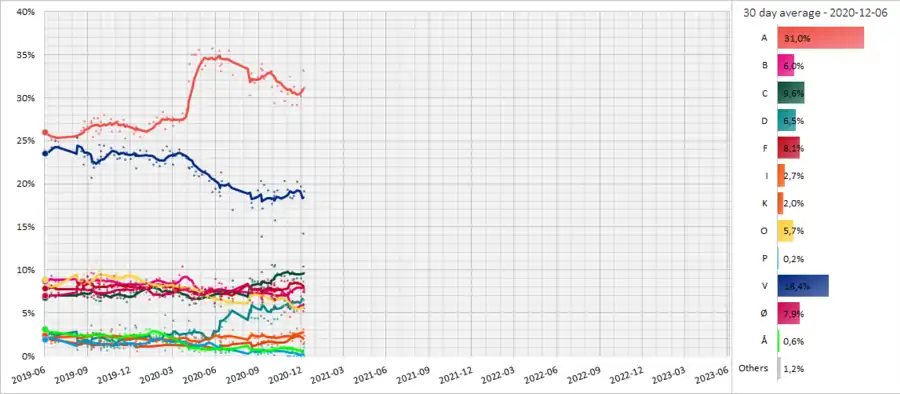Next Danish general election
General elections are scheduled to be held in Denmark by 4 June 2023, corresponding to the maximum four-year mandate as specified by the constitution, depending on whether a snap election is called.[3] All 179 members of the Folketing will be elected. 175 members will be elected in Denmark proper, two in the Faroe Islands and two in Greenland.
| ||||||||||||||||||||||||||||||||||||||||||||||||||||||||||||||||
All 179 seats in the Folketing 175 from Denmark, 2 from Greenland and 2 from the Faroe Islands. 90 seats are needed for a majority[1] | ||||||||||||||||||||||||||||||||||||||||||||||||||||||||||||||||
|---|---|---|---|---|---|---|---|---|---|---|---|---|---|---|---|---|---|---|---|---|---|---|---|---|---|---|---|---|---|---|---|---|---|---|---|---|---|---|---|---|---|---|---|---|---|---|---|---|---|---|---|---|---|---|---|---|---|---|---|---|---|---|---|---|
| ||||||||||||||||||||||||||||||||||||||||||||||||||||||||||||||||
 | ||||||||||||||||||||||||||||||||||||||||||||||||||||||||||||||||
| ||||||||||||||||||||||||||||||||||||||||||||||||||||||||||||||||
Background
The 2019 Danish general election ended with a 91 seats win for the Social Democrats and Mette Frederiksen and their supporting parties. 22 days later, a minority government was formed by the Social Democrats. The government was supported by the other parties in the "red bloc", the Socialist People's Party, the Social Liberal Party, and the Red–Green Alliance. Mette Frederiksen, the leader of the Social Democrats, became Prime Minister.[4]
Electoral system
The 179 members of the Folketing are elected in Denmark (175), the Faroe Islands (2) and Greenland (2). The 175 seats in Denmark include 135 seats elected in ten multi-member constituencies by proportional representation, using a modified version of the Sainte-Laguë method and Hare quota, and 40 "top-up" seats, allocated to parties in order to address any imbalance in the distribution of the constituency seats.[5]
According to the Danish Constitution, the election will have to be held no later than 4 June 2023, as the last election was held on 5 June 2019. The Prime Minister is able to call the election at any date, provided that date is no later than four years from the previous election, and this is often cited as a tactical advantage to the sitting government, as it can call an early election when polls are favourable. For instance Lars Løkke Rasmussen, the previous prime minister, did announce on 7 May 2019 that elections would be held on 5 June 2019.[6] The latest date for that election was 17 June 2019.
Parties
The table below lists parties currently represented in the Folketing.
Opinion polls

Notes
- Formally, the Red-Green Alliance have collective leadership, but Skipper is their political spokesperson, and de-facto leader of the party.[2]
References
- "Mandatfordelingen / Folketinger". Folketinget. Retrieved 26 September 2019.
- Hoffmann-Hansen, Henrik; Fabricius, Kitte (10 May 2019). "Overblik: Partierne i Danmark". Kristeligt Dagblad (in Danish). Retrieved 20 May 2019.
- "Danmarks Riges Grundlov (Grundloven) (* 1)". Retsinformation. Retrieved 26 September 2019.
- "Mette Frederiksen bliver Danmarks næste statsminister" (in Danish). Danmarks Radio. 25 June 2019. Retrieved 26 September 2019.
- "Folketinget (The Danish Parliament)". Inter-Parliamentary Union. 10 April 1991. Retrieved 26 September 2019.
- "Lars Løkke Rasmussen udskriver folketingsvalg". Danmarks Radio. 27 May 2015. Retrieved 26 September 2019.
External links
- Election polling and trends Politiken.dk
- Greenland Folketing Election Results Qinersineq